《食品加工原理》课程PPT教学课件(福建农林大学)Chapter 8 DEHYDRATION
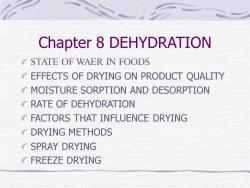
Chapter 8 DEHYDRATION STATE OF WAER IN FOODS EFFECTS OF DRYING ON PRODUCT QUALITY MOISTURE SORPTION AND DESORPTION RATE OF DEHYDRATION FACTORS THAT INFLUENCE DRYING DRYING METHODS SPRAY DRYING FREEZE DRYING
Chapter 8 DEHYDRATION STATE OF WAER IN FOODS EFFECTS OF DRYING ON PRODUCT QUALITY MOISTURE SORPTION AND DESORPTION RATE OF DEHYDRATION FACTORS THAT INFLUENCE DRYING DRYING METHODS SPRAY DRYING FREEZE DRYING

Vocabulary Drying, dehydrate, rehydrate, equilibrium relative humidity, water activity, isotherms sorption desorption hysteresis behavior hypothesis capillary semiempirical empirical, critical moisture content
Vocabulary Drying, dehydrate, rehydrate, equilibrium relative humidity, water activity, isotherms sorption desorption hysteresis behavior hypothesis capillary semiempirical empirical, critical moisture content
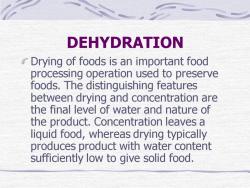
DEHYDRATION Drying of foods is an important food processing operation used to preserve foods. The distinguishing features between drying and concentration are the final level of water and nature of the product. Concentration leaves a liquid food, whereas drying typically produces product with water content sufficiently low to give solid food
DEHYDRATION Drying of foods is an important food processing operation used to preserve foods. The distinguishing features between drying and concentration are the final level of water and nature of the product. Concentration leaves a liquid food, whereas drying typically produces product with water content sufficiently low to give solid food

Reasons for drying foods Historically, there was a need to preserve foods for longer times so that food was available during times of limited food production or availability. Hunters needed a technique to preserve meat for more than a few days to ensure a continuous food supply In the same manner, we have techniques that allow us to preserve foods as they are harvested, so that we can enjoy them at later times
Reasons for drying foods Historically, there was a need to preserve foods for longer times so that food was available during times of limited food production or availability. Hunters needed a technique to preserve meat for more than a few days to ensure a continuous food supply In the same manner, we have techniques that allow us to preserve foods as they are harvested, so that we can enjoy them at later times
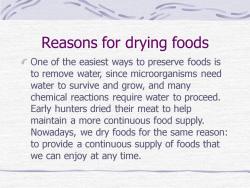
Reasons for drying foods One of the easiest ways to preserve foods is to remove water, since microorganisms need water to survive and grow, and many chemical reactions require water to proceed. Early hunters dried their meat to help maintain a more continuous food supply. Nowadays, we dry foods for the same reason: to provide a continuous supply of foods that we can enjoy at any time
Reasons for drying foods One of the easiest ways to preserve foods is to remove water, since microorganisms need water to survive and grow, and many chemical reactions require water to proceed. Early hunters dried their meat to help maintain a more continuous food supply. Nowadays, we dry foods for the same reason: to provide a continuous supply of foods that we can enjoy at any time
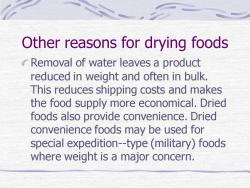
Other reasons for drying foods Removal of water leaves a product reduced in weight and often in bulk. This reduces shipping costs and makes the food supply more economical. Dried foods also provide convenience. Dried convenience foods may be used for special expedition-type (military) foods where weight is a major concern
Other reasons for drying foods Removal of water leaves a product reduced in weight and often in bulk. This reduces shipping costs and makes the food supply more economical. Dried foods also provide convenience. Dried convenience foods may be used for special expedition-type (military) foods where weight is a major concern
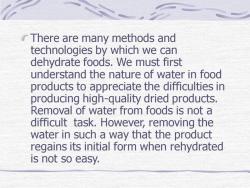
There are many methods and technologies by which we can dehydrate foods. We must first understand the nature of water in food products to appreciate the difficulties in producing high-quality dried products. Removal of water from foods is not a difficult task. However, removing the water in such a way that the product regains its initial form when rehydrated is not so easy
There are many methods and technologies by which we can dehydrate foods. We must first understand the nature of water in food products to appreciate the difficulties in producing high-quality dried products. Removal of water from foods is not a difficult task. However, removing the water in such a way that the product regains its initial form when rehydrated is not so easy
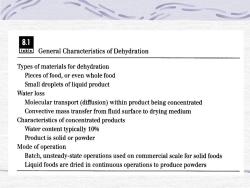
8.1 tabl回 General Characteristics of Dehydration Types of materials for dehydration Pieces of food,or even whole food Small droplets of liquid product Water loss Molecular transport(diffusion)within product being concentrated Convective mass transfer from fluid surface to drying medium Characteristics of concentrated products Water content typically 10% Product is solid or powder Mode of operation Batch,unsteady-state operations used on commercial scale for solid foods Liquid foods are dried in continuous operations to produce powders
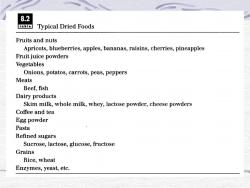
8.2 table Typical Dried Foods Fruits and nuts Apricots,blueberries,apples,bananas,raisins,cherries,pineapples Fruit juice powders Vegetables Onions,potatos,carrots,peas,peppers Meats Beef,fish Dairy products Skim milk,whole milk,whey,lactose powder,cheese powders Coffee and tea Egg powder Pasta Refined sugars Sucrose,lactose,glucose,fructose Grains Rice,wheat Enzymes,yeast,etc
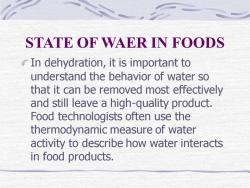
STATE OF WAER IN FOODS In dehydration, it is important to understand the behavior of water so that it can be removed most effectively and still leave a high-quality product. Food technologists often use the thermodynamic measure of water activity to describe how water interacts in food products
STATE OF WAER IN FOODS In dehydration, it is important to understand the behavior of water so that it can be removed most effectively and still leave a high-quality product. Food technologists often use the thermodynamic measure of water activity to describe how water interacts in food products
按次数下载不扣除下载券;
注册用户24小时内重复下载只扣除一次;
顺序:VIP每日次数-->可用次数-->下载券;
- 《食品加工原理》课程PPT教学课件(福建农林大学)Chapter 7 LIQUID CONC.ppt
- 《食品加工原理》课程PPT教学课件(福建农林大学)Chapter 6 FREEZING AND FROZEN-FOOD STORAGE.ppt
- 《食品加工原理》课程PPT教学课件(福建农林大学)Chapter 5 REFRIGERATED STORAGE.ppt
- 《食品加工原理》课程PPT教学课件(福建农林大学)Chapter 4 COMMERCIAL STERILIZATION.ppt
- 《食品加工原理》课程PPT教学课件(福建农林大学)Chapter 3 PASTEURIZATION AND BLANCHING.ppt
- 《食品加工原理》课程PPT教学课件(福建农林大学)Chapter 2 THERMAL PROCESSING PRINCIPLES.ppt
- 《食品加工原理》课程PPT教学课件(福建农林大学)Chapter 1 INTRODUCTION.ppt
- 天津农学院:《食品工艺学》课程教学资源(实验指导)食品工艺学实验任务书(共七章).doc
- 河南农业大学:《食品工艺学》课程教学资源(教案讲义)第五篇 软饮料工艺学.doc
- 河南农业大学:《食品工艺学》课程教学资源(PPT课件)第五篇 软饮料工艺学 5.5 第五章 瓶装水饮料.ppt
- 河南农业大学:《食品工艺学》课程教学资源(PPT课件)第五篇 软饮料工艺学 5.4 第四章 植物蛋白饮料.ppt
- 河南农业大学:《食品工艺学》课程教学资源(PPT课件)第五篇 软饮料工艺学 5.3 第三章 果蔬汁饮料.ppt
- 河南农业大学:《食品工艺学》课程教学资源(PPT课件)第五篇 软饮料工艺学 5.2 第二章 碳酸饮料.ppt
- 河南农业大学:《食品工艺学》课程教学资源(PPT课件)第五篇 软饮料工艺学 5.1 第一章 软饮料用原辅材料.ppt
- 河南农业大学:《食品工艺学》课程教学资源(教案讲义)第四篇 果蔬食品加工学.doc
- 河南农业大学:《食品工艺学》课程教学资源(PPT课件)第四篇 果蔬食品加工学 4.4 第四章 蔬菜腌制工艺.ppt
- 河南农业大学:《食品工艺学》课程教学资源(PPT课件)第四篇 果蔬食品加工学 4.3 第三章 果蔬干制工艺.ppt
- 河南农业大学:《食品工艺学》课程教学资源(PPT课件)第四篇 果蔬食品加工学 4.2 第二章 果蔬糖制工艺.ppt
- 河南农业大学:《食品工艺学》课程教学资源(PPT课件)第四篇 果蔬食品加工学 4.1 第一章 果蔬罐头工艺.ppt
- 河南农业大学:《食品工艺学》课程教学资源(教案讲义)第三篇 面制食品工艺学.doc
- 《食品加工原理》课程PPT教学课件(福建农林大学)Chapter 9 OTHER SEPARATION PROCESSES.ppt
- 《食品工艺学》课程电子教案(PPT教学课件)绪论、第一章 罐头食品工艺.ppt
- 《食品工艺学》课程电子教案(PPT教学课件)第二章 软饮料工艺.ppt
- 《食品工艺学》课程电子教案(PPT教学课件)第三章 糕点食品工艺.ppt
- 《食品工艺学》课程电子教案(PPT教学课件)第四章 糖果食品工艺.ppt
- 《食品工艺学》课程电子教案(PPT教学课件)第五章 酒类生产及酱油、食醋、酸奶的制作.ppt
- 《食品工艺学》课程电子教案(PPT教学课件)第六章 脱水食品工艺.ppt
- 《食品工艺学》课程电子教案(PPT教学课件)第七章 食品冷加工工艺.ppt
- 江南大学:《食品工艺学》课程教学资源(PPT课件)第一章 绪论(主讲:夏文水、陈洁、许学勤、陶谦).ppt
- 江南大学:《食品工艺学》课程教学资源(PPT课件)第二章 食品的脱水加工.ppt
- 江南大学:《食品工艺学》课程教学资源(PPT课件)第三章 食品的热处理与杀菌.ppt
- 江南大学:《食品工艺学》课程教学资源(PPT课件)第四章 食品的冷冻保藏.ppt
- 江南大学:《食品工艺学》课程教学资源(PPT课件)第五章 食品的腌渍发酵和烟熏处理.ppt
- 江南大学:《食品工艺学》课程教学资源(PPT课件)第六章 食品的化学保藏.ppt
- 江南大学:《食品工艺学》课程教学资源(PPT课件)第七章 食品的辐射保藏.ppt
- 广西工商职业技术学院:《食品分析与检验》课程教学课件(PPT讲稿)第一章 绪论(任课教师:陈宁春、蒲海燕、谢伟燕、谢洁、张国良).ppt
- 广西工商职业技术学院:《食品分析与检验》课程教学课件(PPT讲稿)第一章 绪论 1.1 溶液浓度的表示 1.2 实验数据的记录和理 1.3 实验室用水 1.4 化学试剂 1.5 实验室安全及防护.ppt
- 广西工商职业技术学院:《食品分析与检验》课程教学课件(PPT讲稿)第一章 绪论 1.6 样品采集、制备和保存.ppt
- 广西工商职业技术学院:《食品分析与检验》课程教学课件(PPT讲稿)第一章 绪论 1.7 样品的预处理.ppt
- 广西工商职业技术学院:《食品分析与检验》课程教学课件(PPT讲稿)第一章 绪论 1.9 常用器皿的使用 1.10 常用玻璃器皿的洗涤与干燥.ppt
